Occupational Health and Safety Risk Assessment at Streakers Salon
VerifiedAdded on 2021/04/21
|17
|3364
|17
Report
AI Summary
This report provides a comprehensive occupational health and safety (OHS) risk assessment for Streakers hair and beauty salon. It identifies biological, chemical, and physical hazards, assessing their likelihood and potential impact. The report then details control measures based on the hierarchy of control, including elimination, substitution, engineering controls, administrative controls, and personal protective equipment. The effectiveness of these controls is monitored and reviewed, with a reassessment of risks based on ALARP (As Low As Reasonably Practicable) principles. The report also includes a plant purchasing policy for future purchases and concludes with a summary of findings and recommendations, adhering to Singaporean guidelines. The report emphasizes the importance of proactive safety measures to ensure a safe workplace environment and mitigate potential risks to employees and clients. The assessment is based on the WHS Council Code of Practice on Risk Management and MOM (Ministry of Manpower) guidelines.
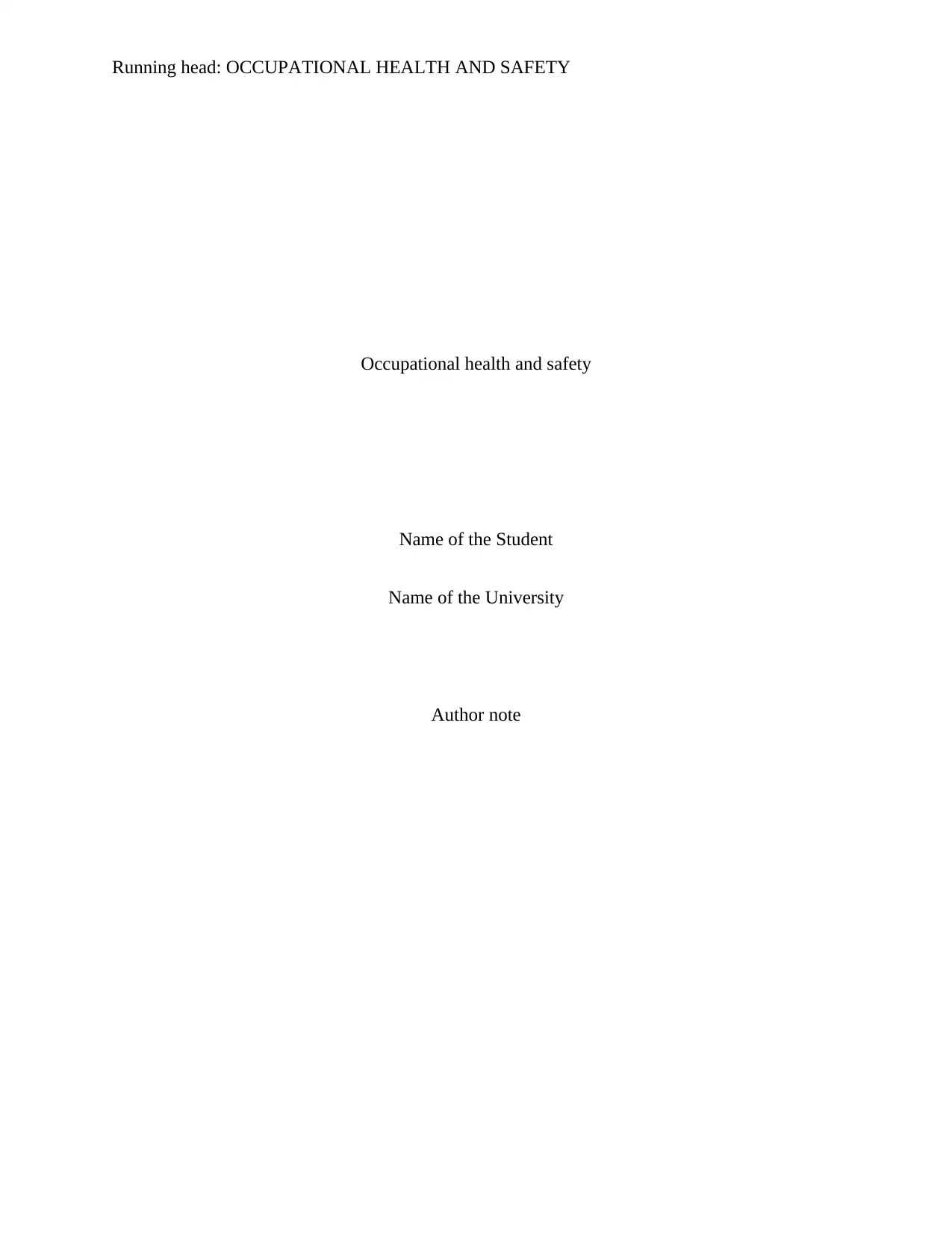
Running head: OCCUPATIONAL HEALTH AND SAFETY
Occupational health and safety
Name of the Student
Name of the University
Author note
Occupational health and safety
Name of the Student
Name of the University
Author note
Paraphrase This Document
Need a fresh take? Get an instant paraphrase of this document with our AI Paraphraser
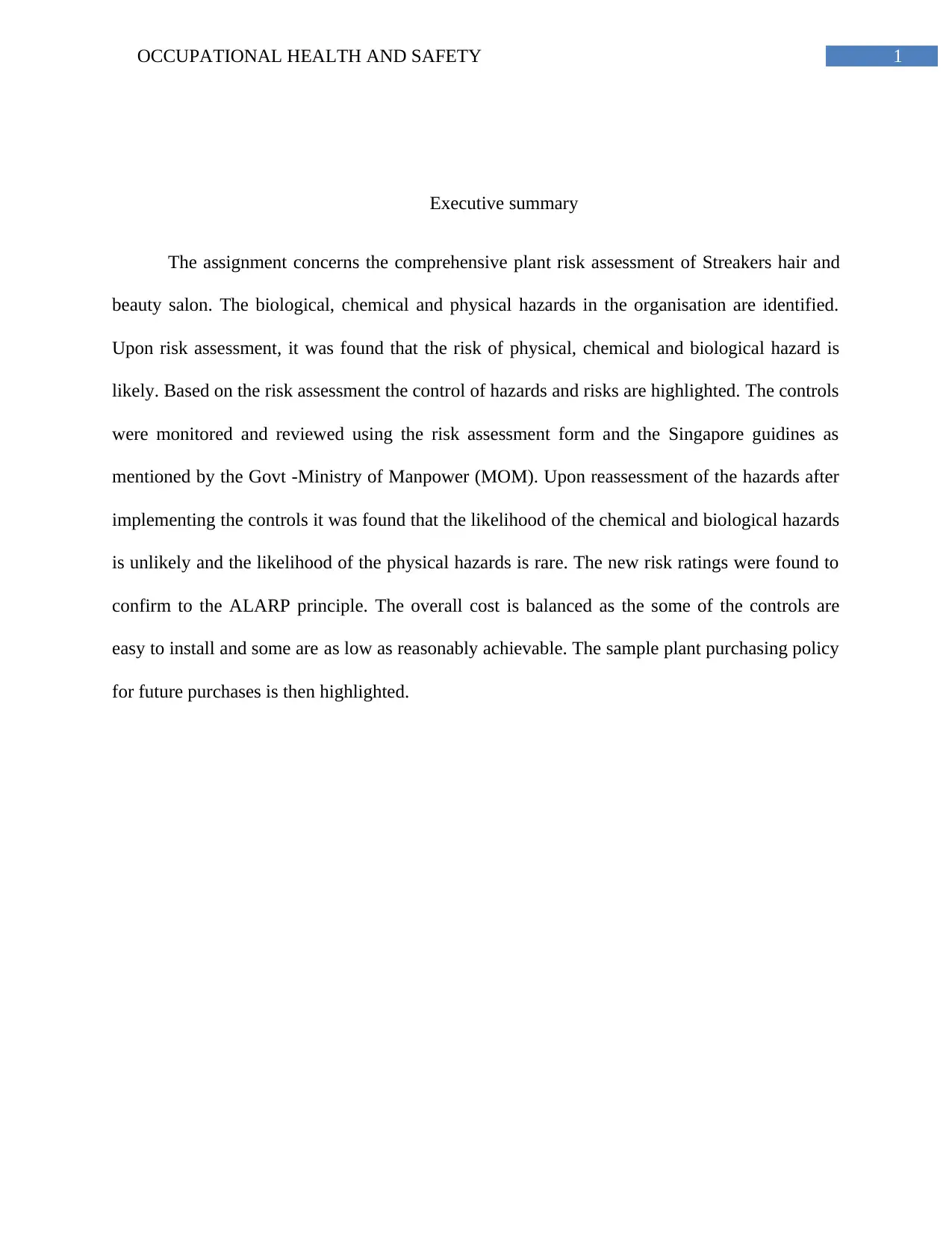
1OCCUPATIONAL HEALTH AND SAFETY
Executive summary
The assignment concerns the comprehensive plant risk assessment of Streakers hair and
beauty salon. The biological, chemical and physical hazards in the organisation are identified.
Upon risk assessment, it was found that the risk of physical, chemical and biological hazard is
likely. Based on the risk assessment the control of hazards and risks are highlighted. The controls
were monitored and reviewed using the risk assessment form and the Singapore guidines as
mentioned by the Govt -Ministry of Manpower (MOM). Upon reassessment of the hazards after
implementing the controls it was found that the likelihood of the chemical and biological hazards
is unlikely and the likelihood of the physical hazards is rare. The new risk ratings were found to
confirm to the ALARP principle. The overall cost is balanced as the some of the controls are
easy to install and some are as low as reasonably achievable. The sample plant purchasing policy
for future purchases is then highlighted.
Executive summary
The assignment concerns the comprehensive plant risk assessment of Streakers hair and
beauty salon. The biological, chemical and physical hazards in the organisation are identified.
Upon risk assessment, it was found that the risk of physical, chemical and biological hazard is
likely. Based on the risk assessment the control of hazards and risks are highlighted. The controls
were monitored and reviewed using the risk assessment form and the Singapore guidines as
mentioned by the Govt -Ministry of Manpower (MOM). Upon reassessment of the hazards after
implementing the controls it was found that the likelihood of the chemical and biological hazards
is unlikely and the likelihood of the physical hazards is rare. The new risk ratings were found to
confirm to the ALARP principle. The overall cost is balanced as the some of the controls are
easy to install and some are as low as reasonably achievable. The sample plant purchasing policy
for future purchases is then highlighted.
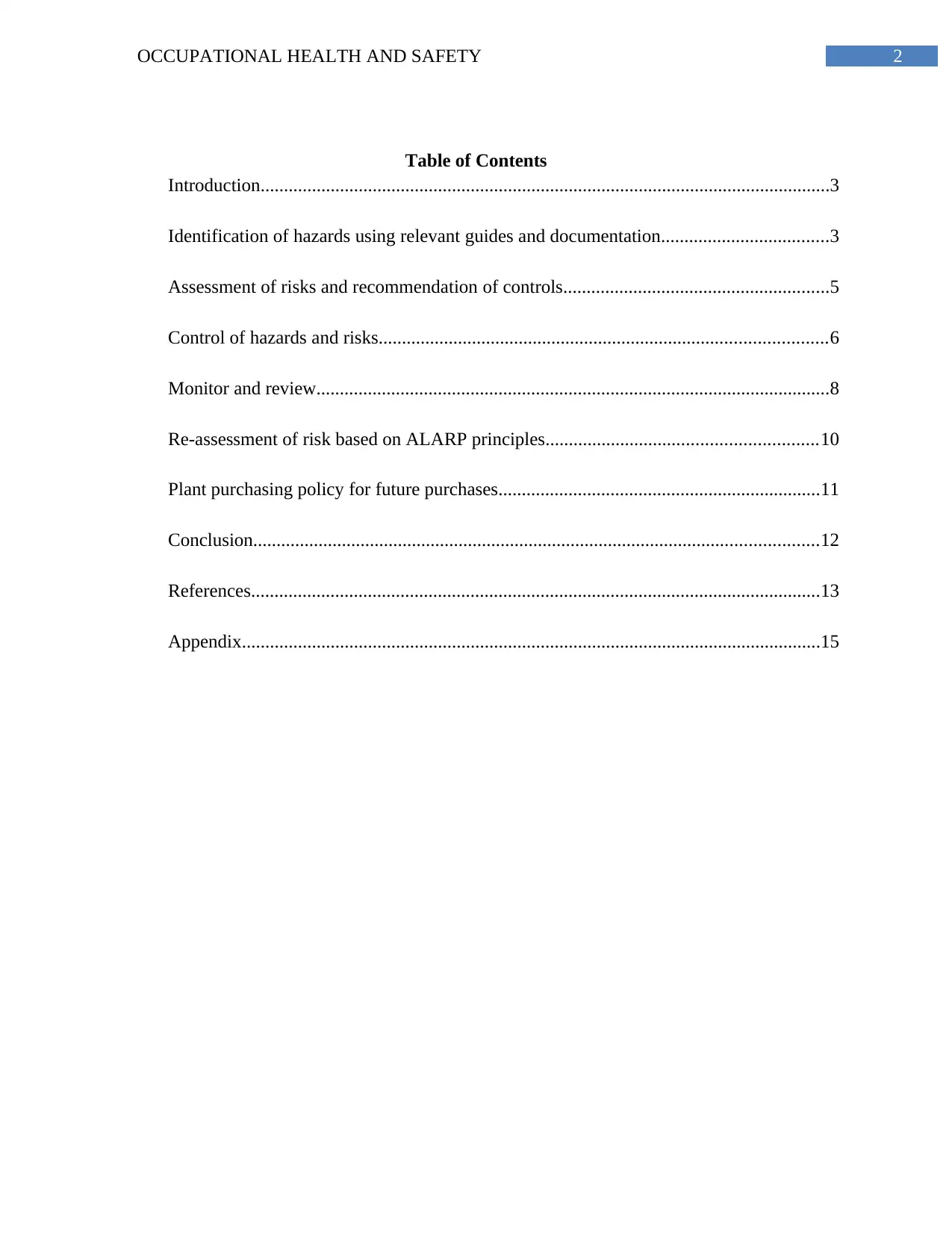
2OCCUPATIONAL HEALTH AND SAFETY
Table of Contents
Introduction..........................................................................................................................3
Identification of hazards using relevant guides and documentation....................................3
Assessment of risks and recommendation of controls.........................................................5
Control of hazards and risks................................................................................................6
Monitor and review..............................................................................................................8
Re-assessment of risk based on ALARP principles..........................................................10
Plant purchasing policy for future purchases.....................................................................11
Conclusion.........................................................................................................................12
References..........................................................................................................................13
Appendix............................................................................................................................15
Table of Contents
Introduction..........................................................................................................................3
Identification of hazards using relevant guides and documentation....................................3
Assessment of risks and recommendation of controls.........................................................5
Control of hazards and risks................................................................................................6
Monitor and review..............................................................................................................8
Re-assessment of risk based on ALARP principles..........................................................10
Plant purchasing policy for future purchases.....................................................................11
Conclusion.........................................................................................................................12
References..........................................................................................................................13
Appendix............................................................................................................................15
⊘ This is a preview!⊘
Do you want full access?
Subscribe today to unlock all pages.

Trusted by 1+ million students worldwide
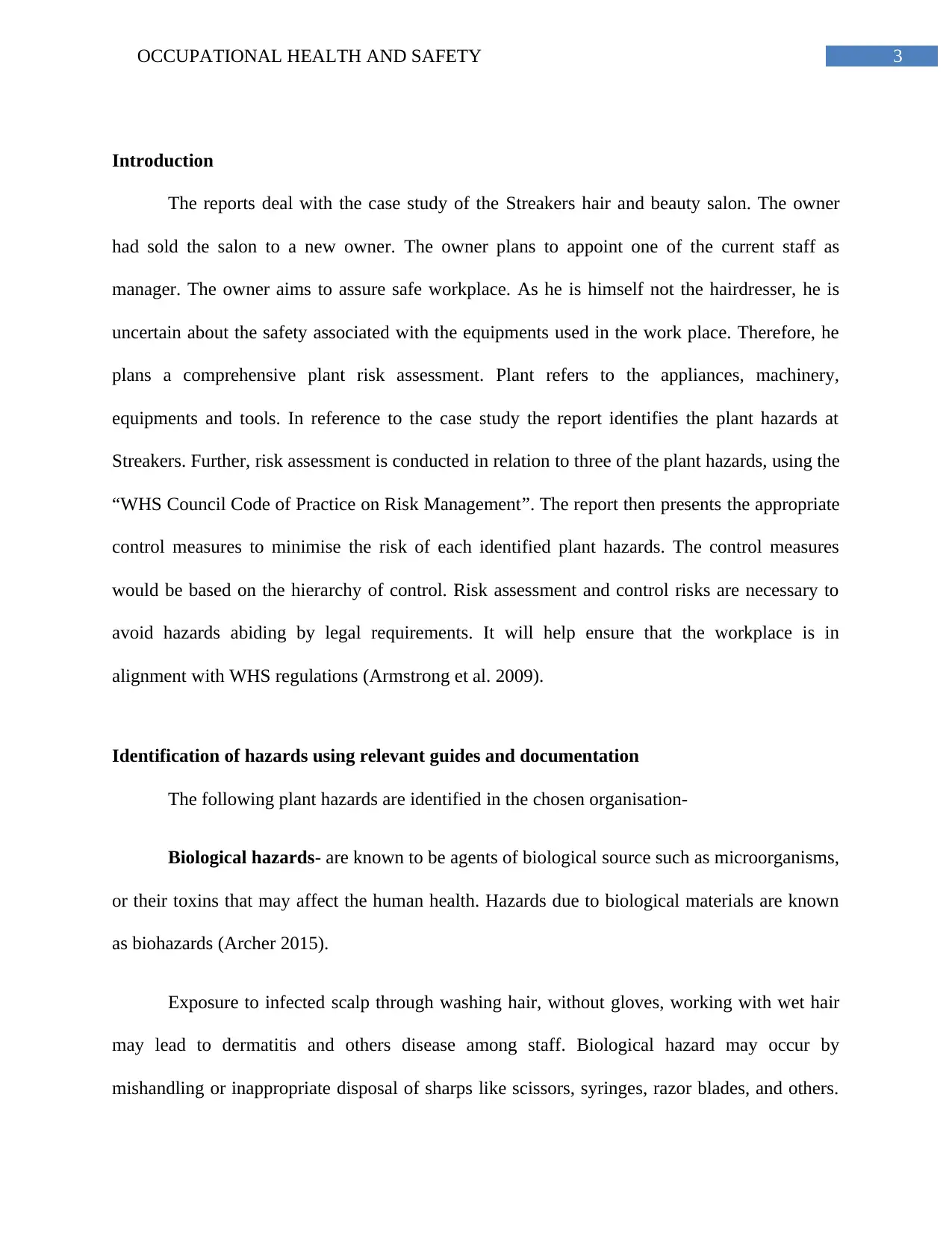
3OCCUPATIONAL HEALTH AND SAFETY
Introduction
The reports deal with the case study of the Streakers hair and beauty salon. The owner
had sold the salon to a new owner. The owner plans to appoint one of the current staff as
manager. The owner aims to assure safe workplace. As he is himself not the hairdresser, he is
uncertain about the safety associated with the equipments used in the work place. Therefore, he
plans a comprehensive plant risk assessment. Plant refers to the appliances, machinery,
equipments and tools. In reference to the case study the report identifies the plant hazards at
Streakers. Further, risk assessment is conducted in relation to three of the plant hazards, using the
“WHS Council Code of Practice on Risk Management”. The report then presents the appropriate
control measures to minimise the risk of each identified plant hazards. The control measures
would be based on the hierarchy of control. Risk assessment and control risks are necessary to
avoid hazards abiding by legal requirements. It will help ensure that the workplace is in
alignment with WHS regulations (Armstrong et al. 2009).
Identification of hazards using relevant guides and documentation
The following plant hazards are identified in the chosen organisation-
Biological hazards- are known to be agents of biological source such as microorganisms,
or their toxins that may affect the human health. Hazards due to biological materials are known
as biohazards (Archer 2015).
Exposure to infected scalp through washing hair, without gloves, working with wet hair
may lead to dermatitis and others disease among staff. Biological hazard may occur by
mishandling or inappropriate disposal of sharps like scissors, syringes, razor blades, and others.
Introduction
The reports deal with the case study of the Streakers hair and beauty salon. The owner
had sold the salon to a new owner. The owner plans to appoint one of the current staff as
manager. The owner aims to assure safe workplace. As he is himself not the hairdresser, he is
uncertain about the safety associated with the equipments used in the work place. Therefore, he
plans a comprehensive plant risk assessment. Plant refers to the appliances, machinery,
equipments and tools. In reference to the case study the report identifies the plant hazards at
Streakers. Further, risk assessment is conducted in relation to three of the plant hazards, using the
“WHS Council Code of Practice on Risk Management”. The report then presents the appropriate
control measures to minimise the risk of each identified plant hazards. The control measures
would be based on the hierarchy of control. Risk assessment and control risks are necessary to
avoid hazards abiding by legal requirements. It will help ensure that the workplace is in
alignment with WHS regulations (Armstrong et al. 2009).
Identification of hazards using relevant guides and documentation
The following plant hazards are identified in the chosen organisation-
Biological hazards- are known to be agents of biological source such as microorganisms,
or their toxins that may affect the human health. Hazards due to biological materials are known
as biohazards (Archer 2015).
Exposure to infected scalp through washing hair, without gloves, working with wet hair
may lead to dermatitis and others disease among staff. Biological hazard may occur by
mishandling or inappropriate disposal of sharps like scissors, syringes, razor blades, and others.
Paraphrase This Document
Need a fresh take? Get an instant paraphrase of this document with our AI Paraphraser
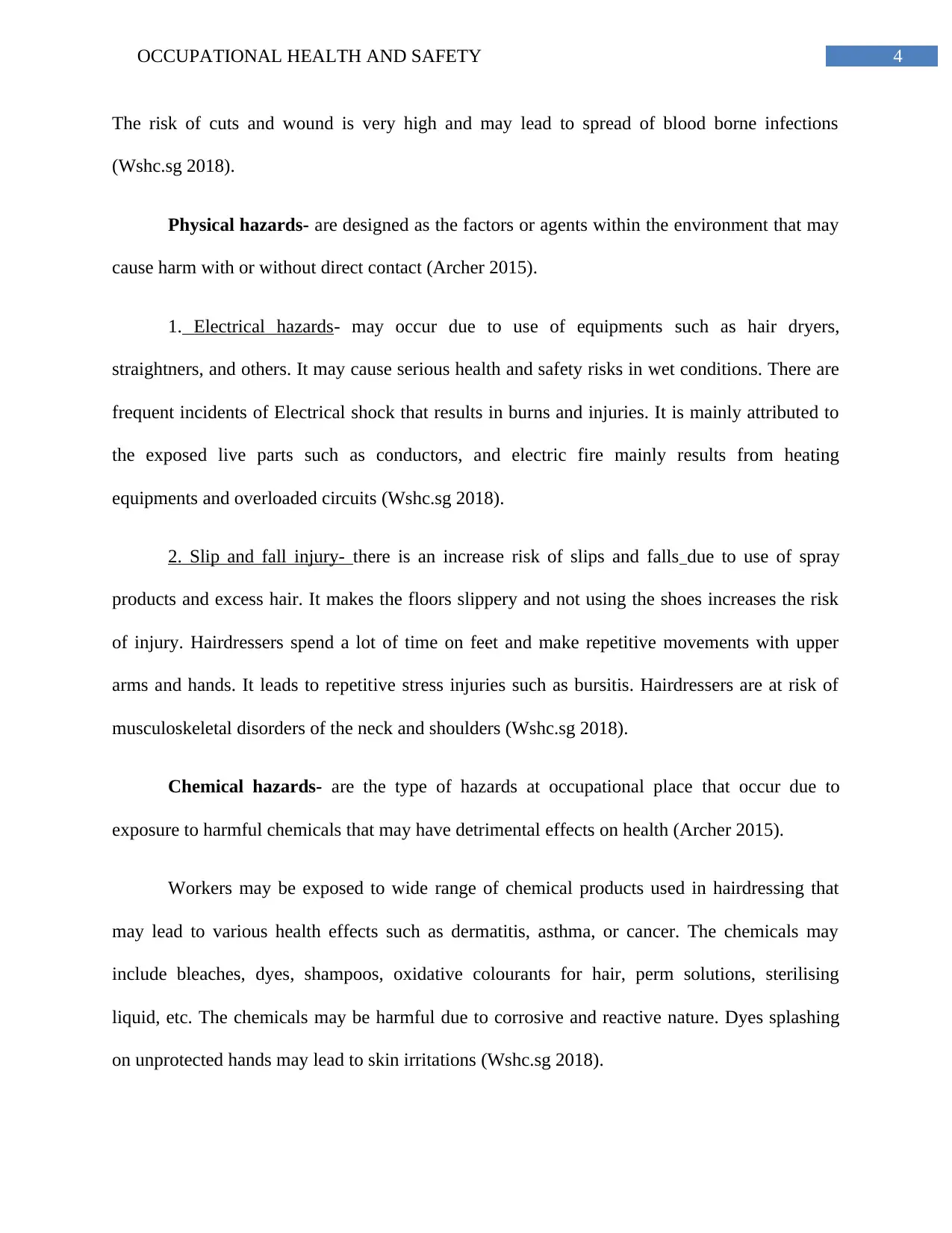
4OCCUPATIONAL HEALTH AND SAFETY
The risk of cuts and wound is very high and may lead to spread of blood borne infections
(Wshc.sg 2018).
Physical hazards- are designed as the factors or agents within the environment that may
cause harm with or without direct contact (Archer 2015).
1. Electrical hazards- may occur due to use of equipments such as hair dryers,
straightners, and others. It may cause serious health and safety risks in wet conditions. There are
frequent incidents of Electrical shock that results in burns and injuries. It is mainly attributed to
the exposed live parts such as conductors, and electric fire mainly results from heating
equipments and overloaded circuits (Wshc.sg 2018).
2. Slip and fall injury- there is an increase risk of slips and falls due to use of spray
products and excess hair. It makes the floors slippery and not using the shoes increases the risk
of injury. Hairdressers spend a lot of time on feet and make repetitive movements with upper
arms and hands. It leads to repetitive stress injuries such as bursitis. Hairdressers are at risk of
musculoskeletal disorders of the neck and shoulders (Wshc.sg 2018).
Chemical hazards- are the type of hazards at occupational place that occur due to
exposure to harmful chemicals that may have detrimental effects on health (Archer 2015).
Workers may be exposed to wide range of chemical products used in hairdressing that
may lead to various health effects such as dermatitis, asthma, or cancer. The chemicals may
include bleaches, dyes, shampoos, oxidative colourants for hair, perm solutions, sterilising
liquid, etc. The chemicals may be harmful due to corrosive and reactive nature. Dyes splashing
on unprotected hands may lead to skin irritations (Wshc.sg 2018).
The risk of cuts and wound is very high and may lead to spread of blood borne infections
(Wshc.sg 2018).
Physical hazards- are designed as the factors or agents within the environment that may
cause harm with or without direct contact (Archer 2015).
1. Electrical hazards- may occur due to use of equipments such as hair dryers,
straightners, and others. It may cause serious health and safety risks in wet conditions. There are
frequent incidents of Electrical shock that results in burns and injuries. It is mainly attributed to
the exposed live parts such as conductors, and electric fire mainly results from heating
equipments and overloaded circuits (Wshc.sg 2018).
2. Slip and fall injury- there is an increase risk of slips and falls due to use of spray
products and excess hair. It makes the floors slippery and not using the shoes increases the risk
of injury. Hairdressers spend a lot of time on feet and make repetitive movements with upper
arms and hands. It leads to repetitive stress injuries such as bursitis. Hairdressers are at risk of
musculoskeletal disorders of the neck and shoulders (Wshc.sg 2018).
Chemical hazards- are the type of hazards at occupational place that occur due to
exposure to harmful chemicals that may have detrimental effects on health (Archer 2015).
Workers may be exposed to wide range of chemical products used in hairdressing that
may lead to various health effects such as dermatitis, asthma, or cancer. The chemicals may
include bleaches, dyes, shampoos, oxidative colourants for hair, perm solutions, sterilising
liquid, etc. The chemicals may be harmful due to corrosive and reactive nature. Dyes splashing
on unprotected hands may lead to skin irritations (Wshc.sg 2018).
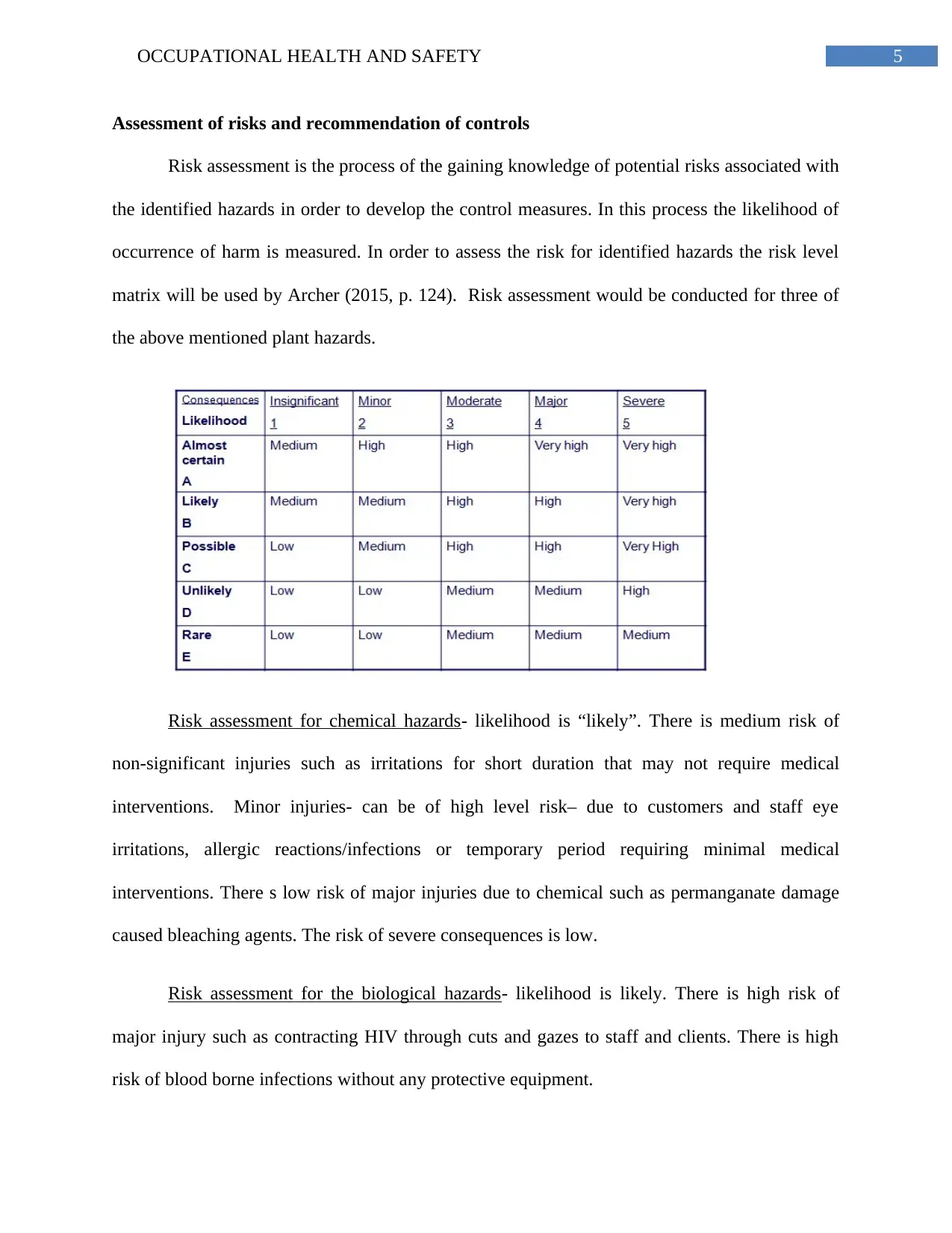
5OCCUPATIONAL HEALTH AND SAFETY
Assessment of risks and recommendation of controls
Risk assessment is the process of the gaining knowledge of potential risks associated with
the identified hazards in order to develop the control measures. In this process the likelihood of
occurrence of harm is measured. In order to assess the risk for identified hazards the risk level
matrix will be used by Archer (2015, p. 124). Risk assessment would be conducted for three of
the above mentioned plant hazards.
Risk assessment for chemical hazards- likelihood is “likely”. There is medium risk of
non-significant injuries such as irritations for short duration that may not require medical
interventions. Minor injuries- can be of high level risk– due to customers and staff eye
irritations, allergic reactions/infections or temporary period requiring minimal medical
interventions. There s low risk of major injuries due to chemical such as permanganate damage
caused bleaching agents. The risk of severe consequences is low.
Risk assessment for the biological hazards- likelihood is likely. There is high risk of
major injury such as contracting HIV through cuts and gazes to staff and clients. There is high
risk of blood borne infections without any protective equipment.
Assessment of risks and recommendation of controls
Risk assessment is the process of the gaining knowledge of potential risks associated with
the identified hazards in order to develop the control measures. In this process the likelihood of
occurrence of harm is measured. In order to assess the risk for identified hazards the risk level
matrix will be used by Archer (2015, p. 124). Risk assessment would be conducted for three of
the above mentioned plant hazards.
Risk assessment for chemical hazards- likelihood is “likely”. There is medium risk of
non-significant injuries such as irritations for short duration that may not require medical
interventions. Minor injuries- can be of high level risk– due to customers and staff eye
irritations, allergic reactions/infections or temporary period requiring minimal medical
interventions. There s low risk of major injuries due to chemical such as permanganate damage
caused bleaching agents. The risk of severe consequences is low.
Risk assessment for the biological hazards- likelihood is likely. There is high risk of
major injury such as contracting HIV through cuts and gazes to staff and clients. There is high
risk of blood borne infections without any protective equipment.
⊘ This is a preview!⊘
Do you want full access?
Subscribe today to unlock all pages.

Trusted by 1+ million students worldwide
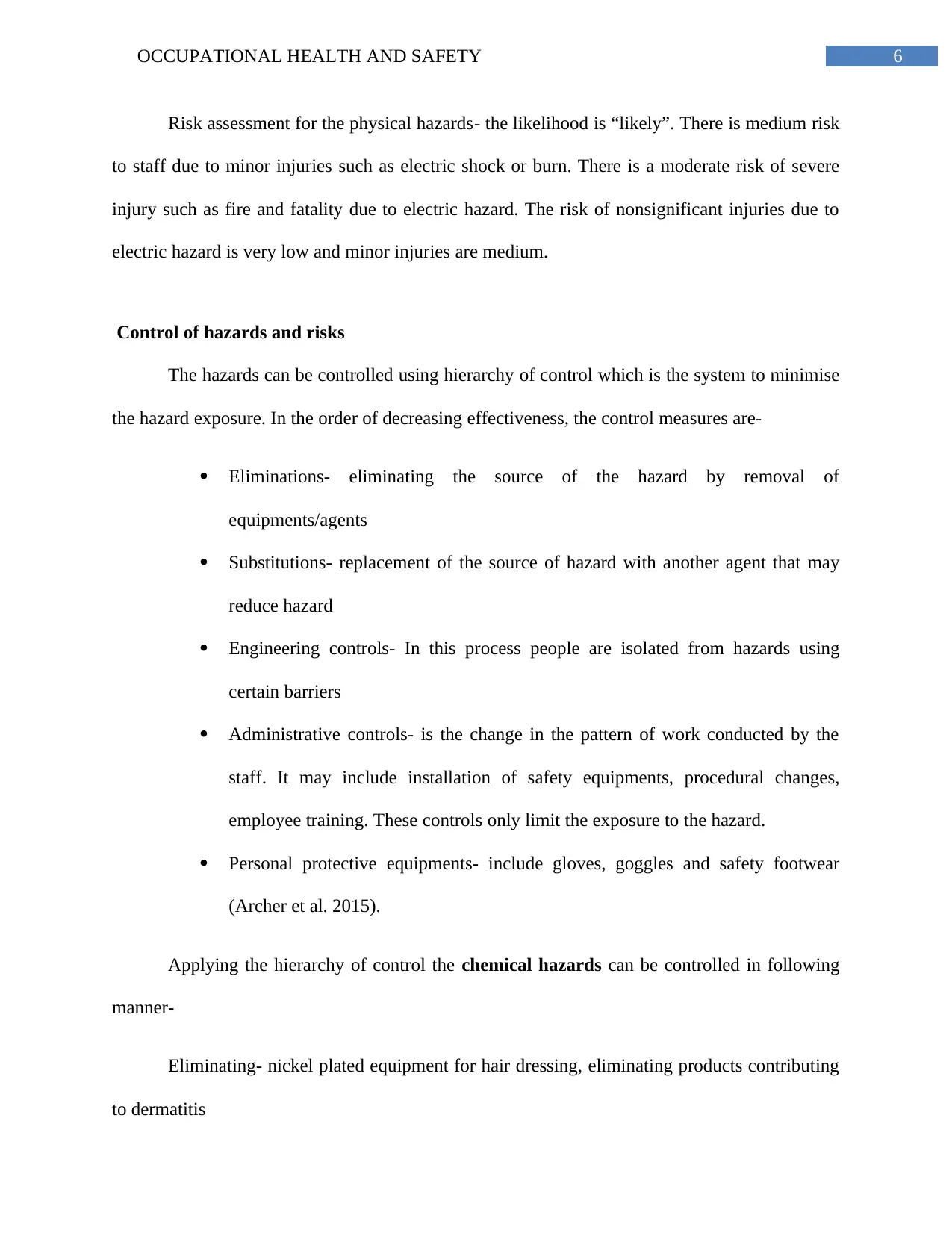
6OCCUPATIONAL HEALTH AND SAFETY
Risk assessment for the physical hazards- the likelihood is “likely”. There is medium risk
to staff due to minor injuries such as electric shock or burn. There is a moderate risk of severe
injury such as fire and fatality due to electric hazard. The risk of nonsignificant injuries due to
electric hazard is very low and minor injuries are medium.
Control of hazards and risks
The hazards can be controlled using hierarchy of control which is the system to minimise
the hazard exposure. In the order of decreasing effectiveness, the control measures are-
Eliminations- eliminating the source of the hazard by removal of
equipments/agents
Substitutions- replacement of the source of hazard with another agent that may
reduce hazard
Engineering controls- In this process people are isolated from hazards using
certain barriers
Administrative controls- is the change in the pattern of work conducted by the
staff. It may include installation of safety equipments, procedural changes,
employee training. These controls only limit the exposure to the hazard.
Personal protective equipments- include gloves, goggles and safety footwear
(Archer et al. 2015).
Applying the hierarchy of control the chemical hazards can be controlled in following
manner-
Eliminating- nickel plated equipment for hair dressing, eliminating products contributing
to dermatitis
Risk assessment for the physical hazards- the likelihood is “likely”. There is medium risk
to staff due to minor injuries such as electric shock or burn. There is a moderate risk of severe
injury such as fire and fatality due to electric hazard. The risk of nonsignificant injuries due to
electric hazard is very low and minor injuries are medium.
Control of hazards and risks
The hazards can be controlled using hierarchy of control which is the system to minimise
the hazard exposure. In the order of decreasing effectiveness, the control measures are-
Eliminations- eliminating the source of the hazard by removal of
equipments/agents
Substitutions- replacement of the source of hazard with another agent that may
reduce hazard
Engineering controls- In this process people are isolated from hazards using
certain barriers
Administrative controls- is the change in the pattern of work conducted by the
staff. It may include installation of safety equipments, procedural changes,
employee training. These controls only limit the exposure to the hazard.
Personal protective equipments- include gloves, goggles and safety footwear
(Archer et al. 2015).
Applying the hierarchy of control the chemical hazards can be controlled in following
manner-
Eliminating- nickel plated equipment for hair dressing, eliminating products contributing
to dermatitis
Paraphrase This Document
Need a fresh take? Get an instant paraphrase of this document with our AI Paraphraser
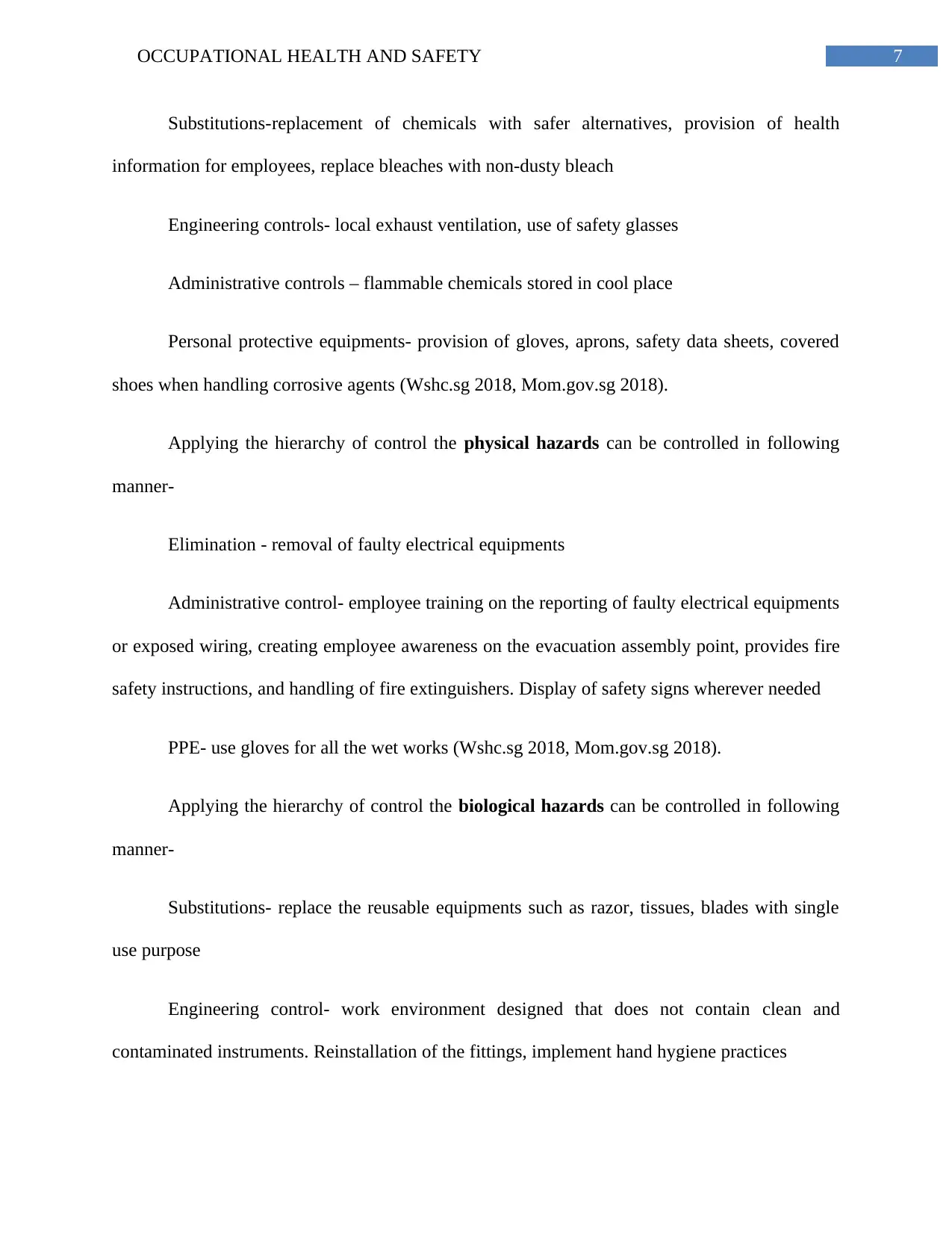
7OCCUPATIONAL HEALTH AND SAFETY
Substitutions-replacement of chemicals with safer alternatives, provision of health
information for employees, replace bleaches with non-dusty bleach
Engineering controls- local exhaust ventilation, use of safety glasses
Administrative controls – flammable chemicals stored in cool place
Personal protective equipments- provision of gloves, aprons, safety data sheets, covered
shoes when handling corrosive agents (Wshc.sg 2018, Mom.gov.sg 2018).
Applying the hierarchy of control the physical hazards can be controlled in following
manner-
Elimination - removal of faulty electrical equipments
Administrative control- employee training on the reporting of faulty electrical equipments
or exposed wiring, creating employee awareness on the evacuation assembly point, provides fire
safety instructions, and handling of fire extinguishers. Display of safety signs wherever needed
PPE- use gloves for all the wet works (Wshc.sg 2018, Mom.gov.sg 2018).
Applying the hierarchy of control the biological hazards can be controlled in following
manner-
Substitutions- replace the reusable equipments such as razor, tissues, blades with single
use purpose
Engineering control- work environment designed that does not contain clean and
contaminated instruments. Reinstallation of the fittings, implement hand hygiene practices
Substitutions-replacement of chemicals with safer alternatives, provision of health
information for employees, replace bleaches with non-dusty bleach
Engineering controls- local exhaust ventilation, use of safety glasses
Administrative controls – flammable chemicals stored in cool place
Personal protective equipments- provision of gloves, aprons, safety data sheets, covered
shoes when handling corrosive agents (Wshc.sg 2018, Mom.gov.sg 2018).
Applying the hierarchy of control the physical hazards can be controlled in following
manner-
Elimination - removal of faulty electrical equipments
Administrative control- employee training on the reporting of faulty electrical equipments
or exposed wiring, creating employee awareness on the evacuation assembly point, provides fire
safety instructions, and handling of fire extinguishers. Display of safety signs wherever needed
PPE- use gloves for all the wet works (Wshc.sg 2018, Mom.gov.sg 2018).
Applying the hierarchy of control the biological hazards can be controlled in following
manner-
Substitutions- replace the reusable equipments such as razor, tissues, blades with single
use purpose
Engineering control- work environment designed that does not contain clean and
contaminated instruments. Reinstallation of the fittings, implement hand hygiene practices
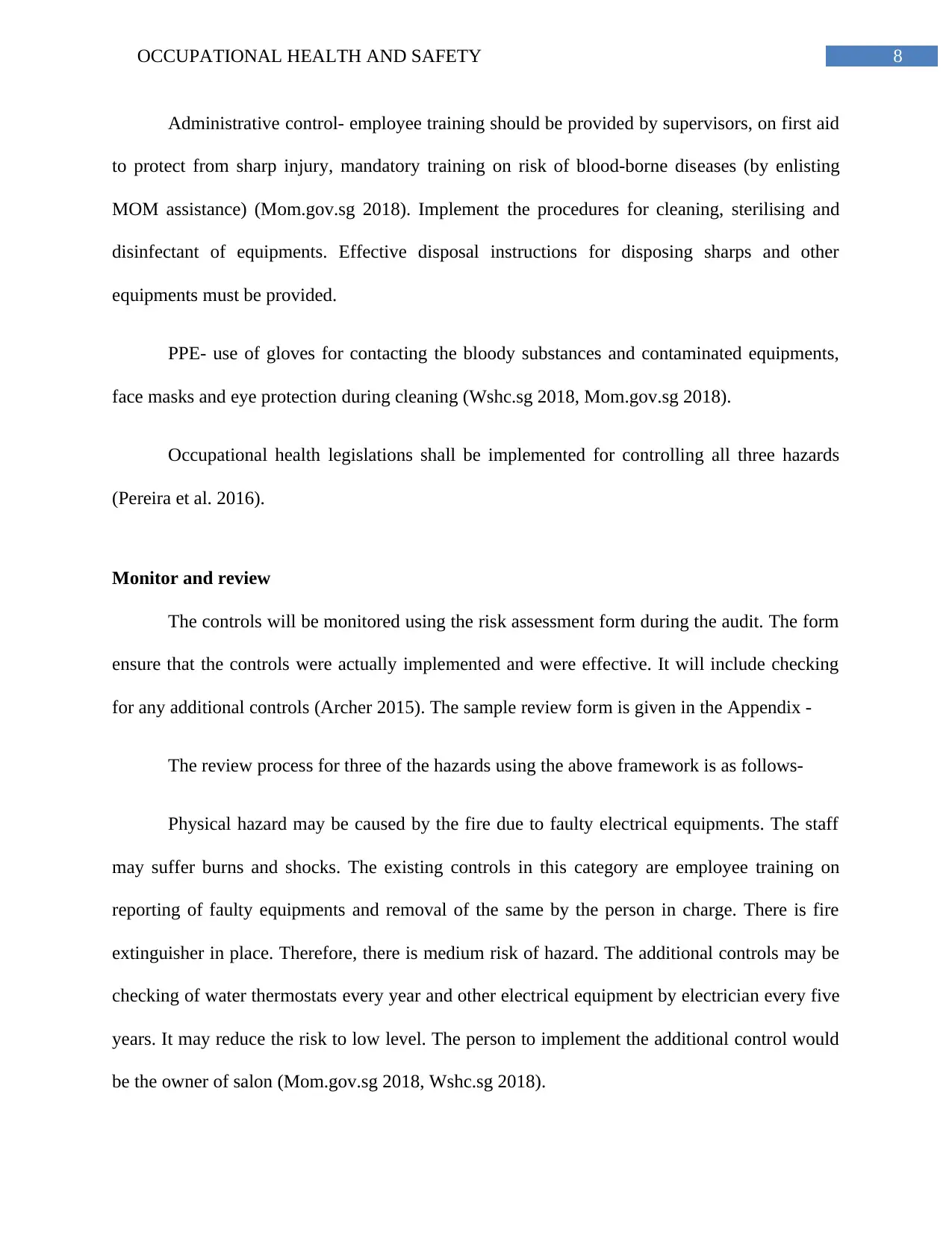
8OCCUPATIONAL HEALTH AND SAFETY
Administrative control- employee training should be provided by supervisors, on first aid
to protect from sharp injury, mandatory training on risk of blood-borne diseases (by enlisting
MOM assistance) (Mom.gov.sg 2018). Implement the procedures for cleaning, sterilising and
disinfectant of equipments. Effective disposal instructions for disposing sharps and other
equipments must be provided.
PPE- use of gloves for contacting the bloody substances and contaminated equipments,
face masks and eye protection during cleaning (Wshc.sg 2018, Mom.gov.sg 2018).
Occupational health legislations shall be implemented for controlling all three hazards
(Pereira et al. 2016).
Monitor and review
The controls will be monitored using the risk assessment form during the audit. The form
ensure that the controls were actually implemented and were effective. It will include checking
for any additional controls (Archer 2015). The sample review form is given in the Appendix -
The review process for three of the hazards using the above framework is as follows-
Physical hazard may be caused by the fire due to faulty electrical equipments. The staff
may suffer burns and shocks. The existing controls in this category are employee training on
reporting of faulty equipments and removal of the same by the person in charge. There is fire
extinguisher in place. Therefore, there is medium risk of hazard. The additional controls may be
checking of water thermostats every year and other electrical equipment by electrician every five
years. It may reduce the risk to low level. The person to implement the additional control would
be the owner of salon (Mom.gov.sg 2018, Wshc.sg 2018).
Administrative control- employee training should be provided by supervisors, on first aid
to protect from sharp injury, mandatory training on risk of blood-borne diseases (by enlisting
MOM assistance) (Mom.gov.sg 2018). Implement the procedures for cleaning, sterilising and
disinfectant of equipments. Effective disposal instructions for disposing sharps and other
equipments must be provided.
PPE- use of gloves for contacting the bloody substances and contaminated equipments,
face masks and eye protection during cleaning (Wshc.sg 2018, Mom.gov.sg 2018).
Occupational health legislations shall be implemented for controlling all three hazards
(Pereira et al. 2016).
Monitor and review
The controls will be monitored using the risk assessment form during the audit. The form
ensure that the controls were actually implemented and were effective. It will include checking
for any additional controls (Archer 2015). The sample review form is given in the Appendix -
The review process for three of the hazards using the above framework is as follows-
Physical hazard may be caused by the fire due to faulty electrical equipments. The staff
may suffer burns and shocks. The existing controls in this category are employee training on
reporting of faulty equipments and removal of the same by the person in charge. There is fire
extinguisher in place. Therefore, there is medium risk of hazard. The additional controls may be
checking of water thermostats every year and other electrical equipment by electrician every five
years. It may reduce the risk to low level. The person to implement the additional control would
be the owner of salon (Mom.gov.sg 2018, Wshc.sg 2018).
⊘ This is a preview!⊘
Do you want full access?
Subscribe today to unlock all pages.

Trusted by 1+ million students worldwide
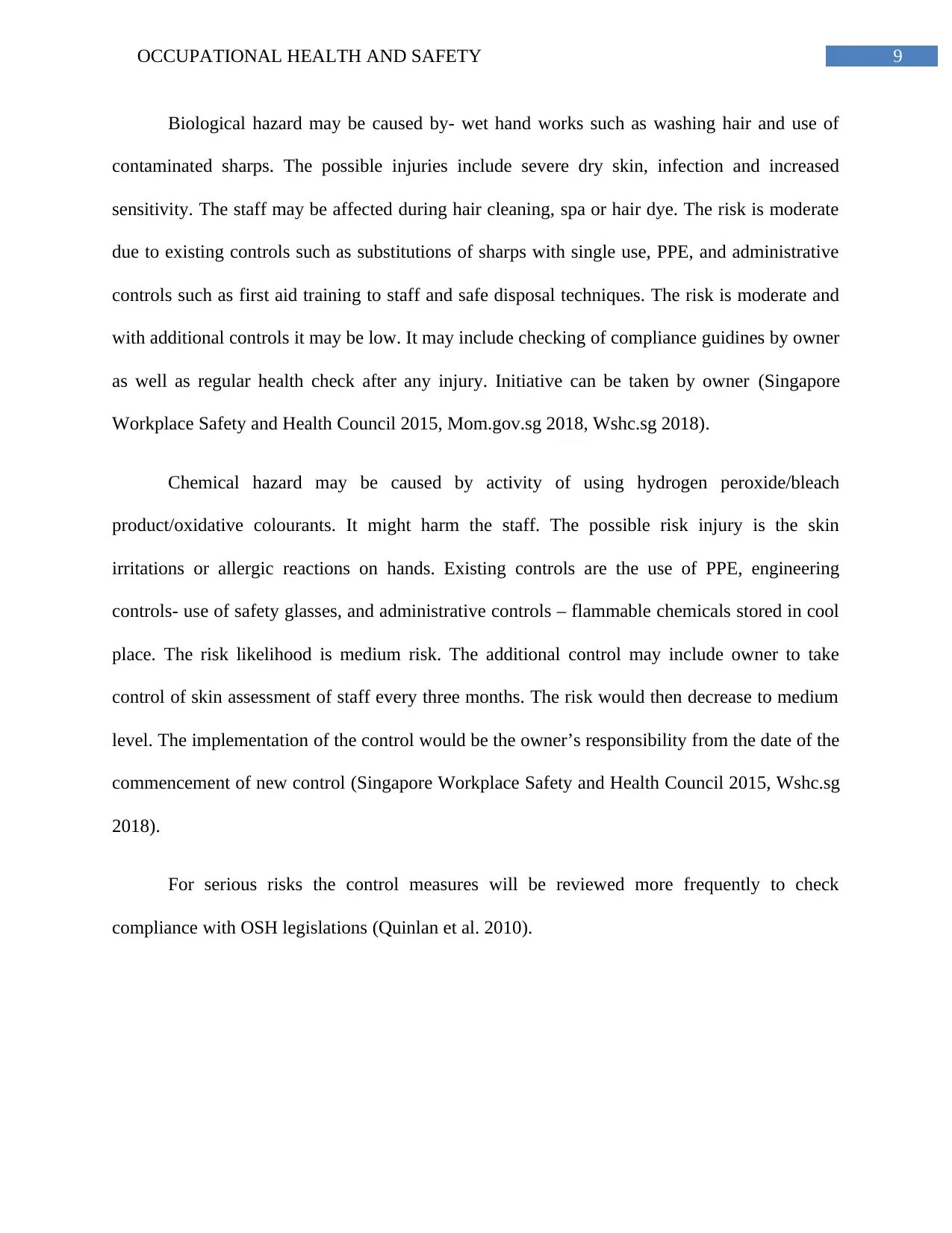
9OCCUPATIONAL HEALTH AND SAFETY
Biological hazard may be caused by- wet hand works such as washing hair and use of
contaminated sharps. The possible injuries include severe dry skin, infection and increased
sensitivity. The staff may be affected during hair cleaning, spa or hair dye. The risk is moderate
due to existing controls such as substitutions of sharps with single use, PPE, and administrative
controls such as first aid training to staff and safe disposal techniques. The risk is moderate and
with additional controls it may be low. It may include checking of compliance guidines by owner
as well as regular health check after any injury. Initiative can be taken by owner (Singapore
Workplace Safety and Health Council 2015, Mom.gov.sg 2018, Wshc.sg 2018).
Chemical hazard may be caused by activity of using hydrogen peroxide/bleach
product/oxidative colourants. It might harm the staff. The possible risk injury is the skin
irritations or allergic reactions on hands. Existing controls are the use of PPE, engineering
controls- use of safety glasses, and administrative controls – flammable chemicals stored in cool
place. The risk likelihood is medium risk. The additional control may include owner to take
control of skin assessment of staff every three months. The risk would then decrease to medium
level. The implementation of the control would be the owner’s responsibility from the date of the
commencement of new control (Singapore Workplace Safety and Health Council 2015, Wshc.sg
2018).
For serious risks the control measures will be reviewed more frequently to check
compliance with OSH legislations (Quinlan et al. 2010).
Biological hazard may be caused by- wet hand works such as washing hair and use of
contaminated sharps. The possible injuries include severe dry skin, infection and increased
sensitivity. The staff may be affected during hair cleaning, spa or hair dye. The risk is moderate
due to existing controls such as substitutions of sharps with single use, PPE, and administrative
controls such as first aid training to staff and safe disposal techniques. The risk is moderate and
with additional controls it may be low. It may include checking of compliance guidines by owner
as well as regular health check after any injury. Initiative can be taken by owner (Singapore
Workplace Safety and Health Council 2015, Mom.gov.sg 2018, Wshc.sg 2018).
Chemical hazard may be caused by activity of using hydrogen peroxide/bleach
product/oxidative colourants. It might harm the staff. The possible risk injury is the skin
irritations or allergic reactions on hands. Existing controls are the use of PPE, engineering
controls- use of safety glasses, and administrative controls – flammable chemicals stored in cool
place. The risk likelihood is medium risk. The additional control may include owner to take
control of skin assessment of staff every three months. The risk would then decrease to medium
level. The implementation of the control would be the owner’s responsibility from the date of the
commencement of new control (Singapore Workplace Safety and Health Council 2015, Wshc.sg
2018).
For serious risks the control measures will be reviewed more frequently to check
compliance with OSH legislations (Quinlan et al. 2010).
Paraphrase This Document
Need a fresh take? Get an instant paraphrase of this document with our AI Paraphraser
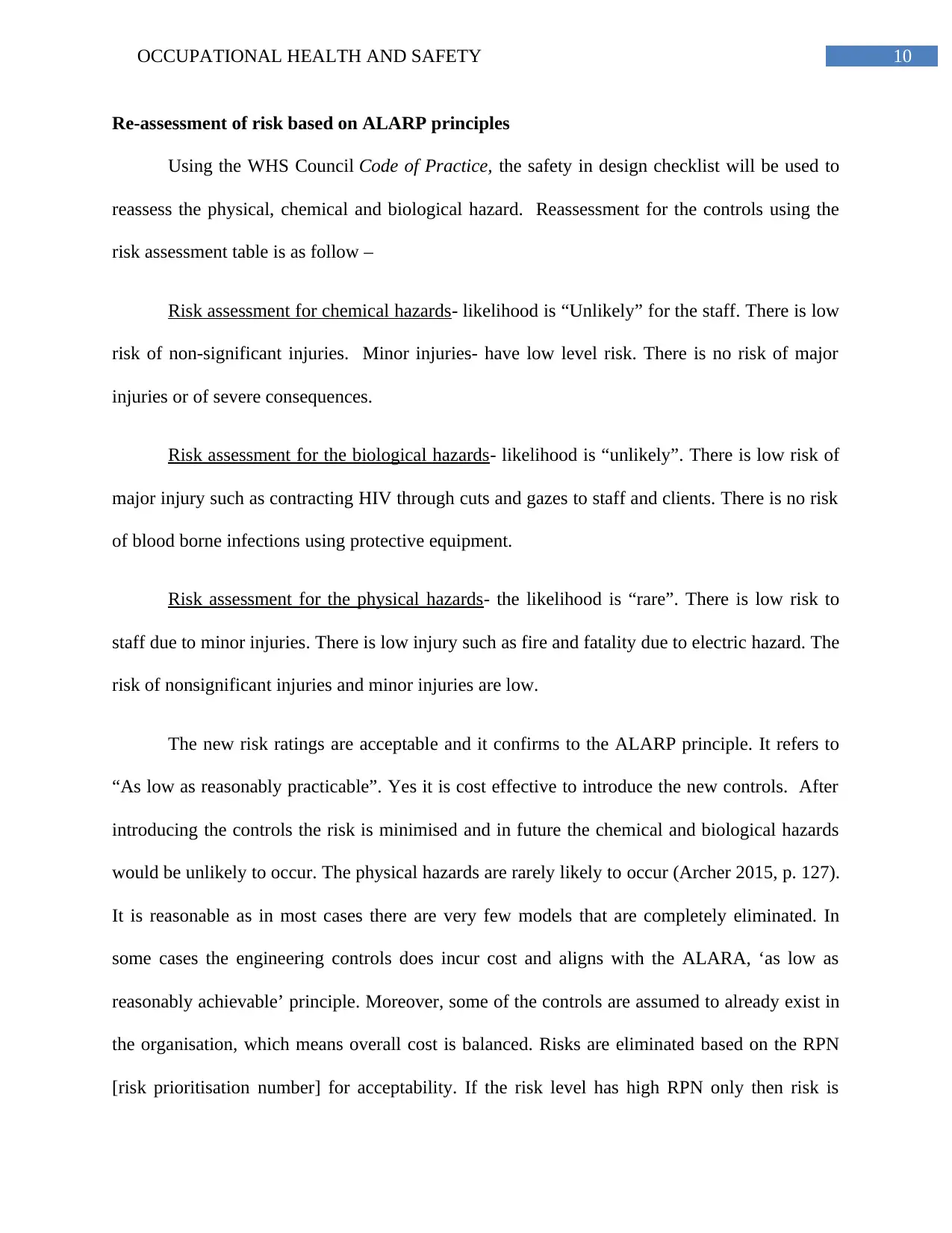
10OCCUPATIONAL HEALTH AND SAFETY
Re-assessment of risk based on ALARP principles
Using the WHS Council Code of Practice, the safety in design checklist will be used to
reassess the physical, chemical and biological hazard. Reassessment for the controls using the
risk assessment table is as follow –
Risk assessment for chemical hazards- likelihood is “Unlikely” for the staff. There is low
risk of non-significant injuries. Minor injuries- have low level risk. There is no risk of major
injuries or of severe consequences.
Risk assessment for the biological hazards- likelihood is “unlikely”. There is low risk of
major injury such as contracting HIV through cuts and gazes to staff and clients. There is no risk
of blood borne infections using protective equipment.
Risk assessment for the physical hazards- the likelihood is “rare”. There is low risk to
staff due to minor injuries. There is low injury such as fire and fatality due to electric hazard. The
risk of nonsignificant injuries and minor injuries are low.
The new risk ratings are acceptable and it confirms to the ALARP principle. It refers to
“As low as reasonably practicable”. Yes it is cost effective to introduce the new controls. After
introducing the controls the risk is minimised and in future the chemical and biological hazards
would be unlikely to occur. The physical hazards are rarely likely to occur (Archer 2015, p. 127).
It is reasonable as in most cases there are very few models that are completely eliminated. In
some cases the engineering controls does incur cost and aligns with the ALARA, ‘as low as
reasonably achievable’ principle. Moreover, some of the controls are assumed to already exist in
the organisation, which means overall cost is balanced. Risks are eliminated based on the RPN
[risk prioritisation number] for acceptability. If the risk level has high RPN only then risk is
Re-assessment of risk based on ALARP principles
Using the WHS Council Code of Practice, the safety in design checklist will be used to
reassess the physical, chemical and biological hazard. Reassessment for the controls using the
risk assessment table is as follow –
Risk assessment for chemical hazards- likelihood is “Unlikely” for the staff. There is low
risk of non-significant injuries. Minor injuries- have low level risk. There is no risk of major
injuries or of severe consequences.
Risk assessment for the biological hazards- likelihood is “unlikely”. There is low risk of
major injury such as contracting HIV through cuts and gazes to staff and clients. There is no risk
of blood borne infections using protective equipment.
Risk assessment for the physical hazards- the likelihood is “rare”. There is low risk to
staff due to minor injuries. There is low injury such as fire and fatality due to electric hazard. The
risk of nonsignificant injuries and minor injuries are low.
The new risk ratings are acceptable and it confirms to the ALARP principle. It refers to
“As low as reasonably practicable”. Yes it is cost effective to introduce the new controls. After
introducing the controls the risk is minimised and in future the chemical and biological hazards
would be unlikely to occur. The physical hazards are rarely likely to occur (Archer 2015, p. 127).
It is reasonable as in most cases there are very few models that are completely eliminated. In
some cases the engineering controls does incur cost and aligns with the ALARA, ‘as low as
reasonably achievable’ principle. Moreover, some of the controls are assumed to already exist in
the organisation, which means overall cost is balanced. Risks are eliminated based on the RPN
[risk prioritisation number] for acceptability. If the risk level has high RPN only then risk is
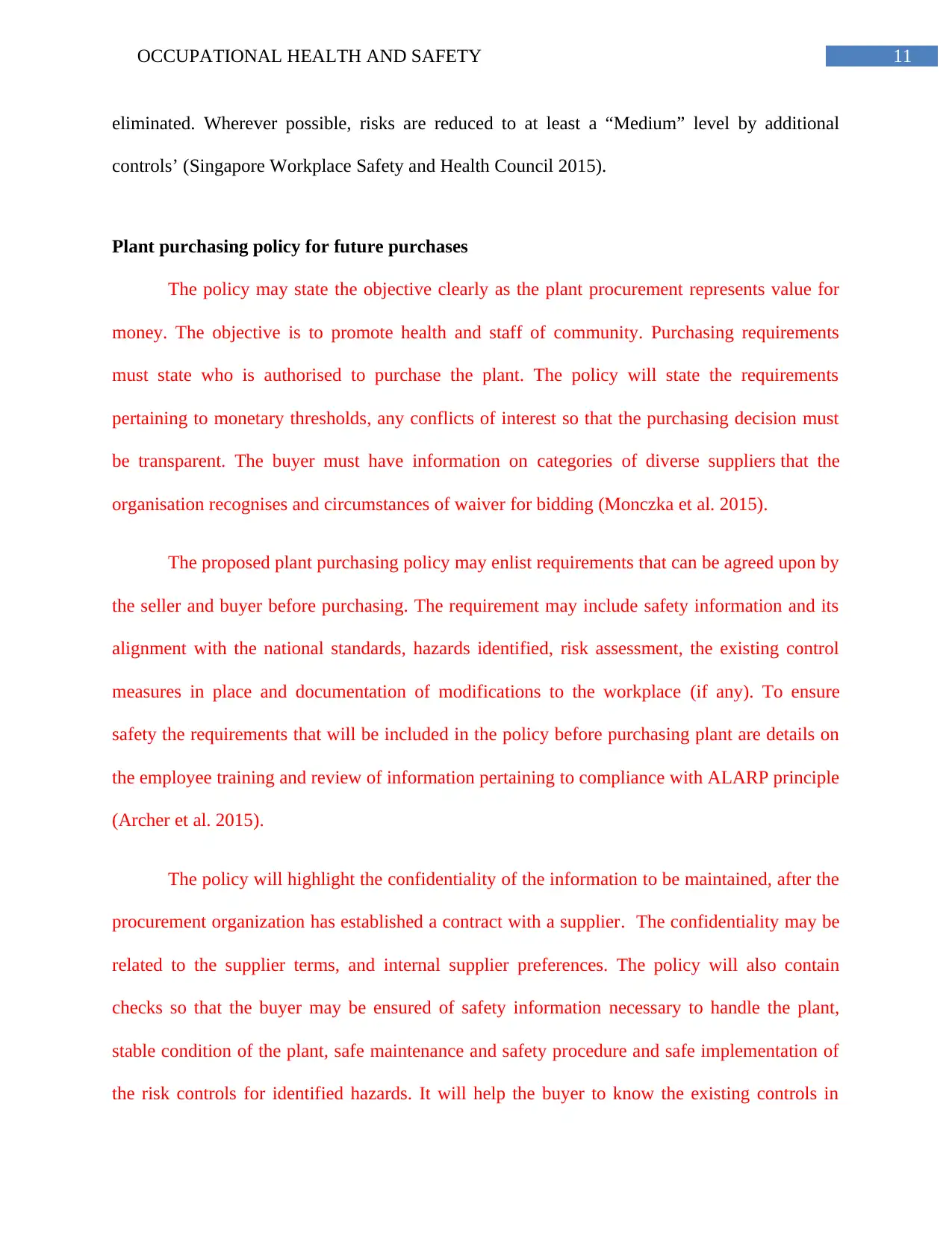
11OCCUPATIONAL HEALTH AND SAFETY
eliminated. Wherever possible, risks are reduced to at least a “Medium” level by additional
controls’ (Singapore Workplace Safety and Health Council 2015).
Plant purchasing policy for future purchases
The policy may state the objective clearly as the plant procurement represents value for
money. The objective is to promote health and staff of community. Purchasing requirements
must state who is authorised to purchase the plant. The policy will state the requirements
pertaining to monetary thresholds, any conflicts of interest so that the purchasing decision must
be transparent. The buyer must have information on categories of diverse suppliers that the
organisation recognises and circumstances of waiver for bidding (Monczka et al. 2015).
The proposed plant purchasing policy may enlist requirements that can be agreed upon by
the seller and buyer before purchasing. The requirement may include safety information and its
alignment with the national standards, hazards identified, risk assessment, the existing control
measures in place and documentation of modifications to the workplace (if any). To ensure
safety the requirements that will be included in the policy before purchasing plant are details on
the employee training and review of information pertaining to compliance with ALARP principle
(Archer et al. 2015).
The policy will highlight the confidentiality of the information to be maintained, after the
procurement organization has established a contract with a supplier. The confidentiality may be
related to the supplier terms, and internal supplier preferences. The policy will also contain
checks so that the buyer may be ensured of safety information necessary to handle the plant,
stable condition of the plant, safe maintenance and safety procedure and safe implementation of
the risk controls for identified hazards. It will help the buyer to know the existing controls in
eliminated. Wherever possible, risks are reduced to at least a “Medium” level by additional
controls’ (Singapore Workplace Safety and Health Council 2015).
Plant purchasing policy for future purchases
The policy may state the objective clearly as the plant procurement represents value for
money. The objective is to promote health and staff of community. Purchasing requirements
must state who is authorised to purchase the plant. The policy will state the requirements
pertaining to monetary thresholds, any conflicts of interest so that the purchasing decision must
be transparent. The buyer must have information on categories of diverse suppliers that the
organisation recognises and circumstances of waiver for bidding (Monczka et al. 2015).
The proposed plant purchasing policy may enlist requirements that can be agreed upon by
the seller and buyer before purchasing. The requirement may include safety information and its
alignment with the national standards, hazards identified, risk assessment, the existing control
measures in place and documentation of modifications to the workplace (if any). To ensure
safety the requirements that will be included in the policy before purchasing plant are details on
the employee training and review of information pertaining to compliance with ALARP principle
(Archer et al. 2015).
The policy will highlight the confidentiality of the information to be maintained, after the
procurement organization has established a contract with a supplier. The confidentiality may be
related to the supplier terms, and internal supplier preferences. The policy will also contain
checks so that the buyer may be ensured of safety information necessary to handle the plant,
stable condition of the plant, safe maintenance and safety procedure and safe implementation of
the risk controls for identified hazards. It will help the buyer to know the existing controls in
⊘ This is a preview!⊘
Do you want full access?
Subscribe today to unlock all pages.

Trusted by 1+ million students worldwide
1 out of 17
Related Documents
Your All-in-One AI-Powered Toolkit for Academic Success.
+13062052269
info@desklib.com
Available 24*7 on WhatsApp / Email
![[object Object]](/_next/static/media/star-bottom.7253800d.svg)
Unlock your academic potential
Copyright © 2020–2025 A2Z Services. All Rights Reserved. Developed and managed by ZUCOL.





